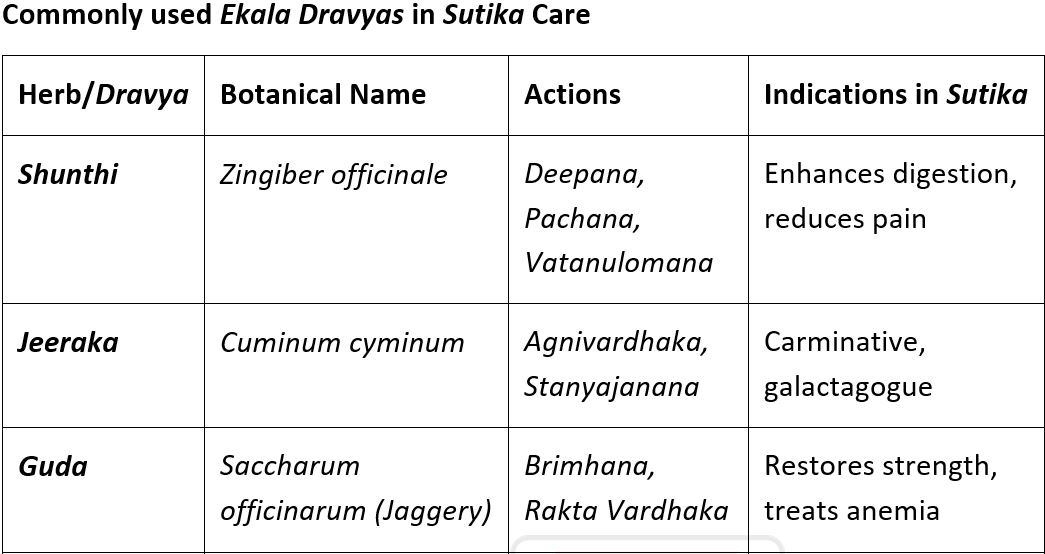Exploring Ekala Dravya Prayoga in Sutika - A Comprehensive Ayurvedic Review
DOI:
https://doi.org/10.21760/jaims.10.7.37Keywords:
Sutika, Ekala Dravya Prayoga, Ayurveda, Postnatal care, Single herb therapy, Shatavari, Jeeraka, ShunthiAbstract
The postpartum period, referred to as Sutika Kaala, is recognized as a significant phase in a woman's life according to Ayurvedic principles. This time is characterized by physical exhaustion, hormonal fluctuations, and an increased susceptibility to imbalances in the Doshas, particularly Vata. Proper management during this period is crucial for restoring maternal health, supporting lactation, and preventing long-term health issues. Traditional Ayurvedic practices place importance on the use of uncomplicated, easily digestible, and safe therapeutic agents to facilitate recovery. One notable method is Ekala Dravya Prayoga, which consists of administering single-drug formulations rather than intricate polyherbal mixtures. This strategy provides several benefits, including simplicity in preparation, a lower chance of adverse interactions, and improved therapeutic accuracy. This detailed review examines various single-drug options traditionally recommended for the Sutika period, discusses their classical references and pharmacological properties, and presents modern evidence supporting their effectiveness. By critically analyzing Ayurvedic literature and correlating it with contemporary scientific findings, the article underscores the significance and potential benefits of Ekala Dravya Prayoga in enhancing postnatal care across both traditional and modern healthcare frameworks. Care for Sutika (postnatal women) is an essential element of Ayurveda, focused on restoring the mother's health, encouraging lactation, and avoiding complications. The use of Ekala Dravya Prayoga - employing single medicinal substances - provides a targeted, effective, and often more tolerable approach during this sensitive period. This review seeks to delve into different single-drug formulations traditionally advocated for Sutika care, outlining their pharmacological effects, indications, and significance in current Ayurvedic practice.
Downloads
References
World Health Organization. WHO recommendations on maternal and newborn care for a positive postnatal experience [Internet]. 2022 [cited 2025 Aug 4]. Available from: https://www.google.com
Shetty HP, Yadav S, Iragamreddy VR. SAHASRA: A thousand paths to women's health in India [Internet]. 2024 [cited 2025 Aug 4]. Available from: https://www.researchgate.net
Dhiman K, Divyamol MD. Sutika Paricharya—Strategies for safe postnatal care in Ayurveda. J Ayurveda Integr Med Sci. 2022 Jun 10;7(3):101–6.
Swati S. International Research Journal of Ayurveda & Yoga [Internet]. [cited 2025 Aug 4]. Available from: https://www.academia.edu
Kamath V. Assessing classification approaches for categorizing Ayurvedic herbs [Internet]. Multimed Tools Appl. 2025 [cited 2025 Aug 4]. Available from: [HTML source]
Mauri M, Calmarza P, Ibarretxe D. Dyslipemias and pregnancy: An update. Clin Investig Arterioscler Engl Ed. 2021 Jan 1;33(1):41–52.
Akter M. Ayurvedic perspectives on immunity enhancement through Rasāyana therapy. J Ayurveda Naturopathy. 2024.
Tjernström K, Lindberg I, Wiklund M, Persson M. Overlooked by the obstetric gaze—How women with persistent health problems due to severe perineal trauma experience encounters with healthcare services: A qualitative study. BMC Health Serv Res. 2024 May 9;24(1):610.
Nath A, Goswami DK. Sutika Paricharya—Postnatal care in Ayurveda. J Ayurveda Integr Med Sci. 2023 Oct 10;8(8):97–101.
Tyagi S, Gauthami M, Tyagi R. Understanding traditions for managing Indian patients during pregnancy and postpartum. Sch Int J Obstet Gynec. 2024.
Sarecka-Hujar B, Szulc-Musioł B. Herbal medicines—Are they effective and safe during pregnancy?. Pharmaceutics. 2022.
MS K, MR A. Ginger revitalized: Exploring the modern applications of Zingiber officinale in medicine and beyond [Internet]. New Armenian Med J. 2024 [cited 2025 Aug 4]. Available from: [HTML source]
Elmalih V. Herbal medicine use during pregnancy, childbirth, and the postnatal period: A cross-sectional study among pregnant women in Cairo. 2024. Available from: https://www.uib.no
Vinod N, Sreelakshmi KS, Neha AR, et al. Beneficial health effects of cumin (Cuminum cyminum) seeds upon incorporation as a potential feed additive in livestock and poultry: A mini-review [Internet]. 2024 [cited 2025 Aug 4]. Available from: https://www.academia.edu
Jaiswal D, Roy A. Dietary practices in various regions of India in postpartum women. Int J Res Innov Soc Sci. 2024;8(9):3544–59.
Rajni VR, Sindhu SC. Influence of Shatavari (Asparagus racemosus) root powder in increasing mother’s milk output and infant’s weight gain. 2024. Available from: https://www.seea.org.in
Pahuja A, Jain M, Rawat K. A review on galactogogic properties of India's rich tradition of medicinal herbs and spices for lactation. Tradit Integr Med. 2024.
Singh SP, Mukadam SS, Bisht A. An extensive investigation into the bioactive component of breast milk, lactation, and clinical application of galactagogues: A review. 2024. Available from: https://www.phytopharmajournal.com
Shilpa J, Anupama V. Role of Sthanika Chikitsa in postmenopausal women care [Internet]. 2021 Nov 18 [cited 2025 Aug 4]. Organized by: Dept. of Prasuti Tantra & Stree-Roga, Parul University. Available from: https://www.paruluniversity.ac.in
Sharma B, Sharma M, Rai S, More AB. Review of clinical and preclinical studies on Ayurveda drugs used in management of liver diseases: A search for proof of concept. J Indian Syst Med. 2021 Oct 1;9(4):226–34.
Upare ND, Badwaik CB, Lade UB. An overview of various medicinal plants used to alleviate constipation [Internet]. 2024 [cited 2025 Aug 4]. Available from: https://www.researchgate.net
Kumar V, Akanksha SS, Yadav AK. The health benefits of ghee: A comparative analysis of Ayurvedic and modern scientific perspectives: A review [Internet]. 2024 [cited 2025 Aug 4]. Available from: https://www.researchgate.net
Martin D. Ayurvedic herbal medicine for beginners: More than 100 remedies for wellness and balance [Internet]. 2022 [cited 2025 Aug 4]. Available from: [HTML source]
Sharma R, Maurya A, Yadav H, et al. Pippali (Piper longum L.): A plant with versatile pharmaceutical uses [Internet]. In: Advances in Medicinal and Aromatic Plants. 2024. Vol. 2:163. Apple Academic Press. Available from: [HTML source]
Saini RK, Meghvansi G, Gupta RK, Sharma VD. Harmonizing health: A holistic exploration of urinary incontinence through Ayurveda and modern medicine [Internet]. 2024 [cited 2025 Aug 4]. Available from: https://www.amazonaws.com
Sanu US, Vernekar SS. Role of Agnihotra in maternal and child healthcare: A narrative review. Indian J Ayurveda Integr Med KLEU. 2023 Jul 1;4(2):41–6.
Miller AR, Stana A. Struggling to recover or recovering the struggle: A critical examination of recovery narratives as discourses-in-practice for people suffering from postpartum depression. Atl J Commun. 2024.
Dewi MK, Chaerunisaa AY, Muhaimin M, Joni IM. Improved activity of herbal medicines through nanotechnology. Nanomaterials. 2022.
Ahmed A, Shuaib M, Shirsat MK, Sharma D. Herbal medicines and recent development on novel herbal drug delivery system. Indones J Pharm Clin Res. 2023 Jul 4;6(1):13–24.
Panda JK, Tanwar S. Scientific applicability in day-to-day practice on Granthokta Sutika Paricharya. J Ayurveda Integr Med Sci. 2023;8(12):119–24.















